- Author: Kathy Keatley Garvey
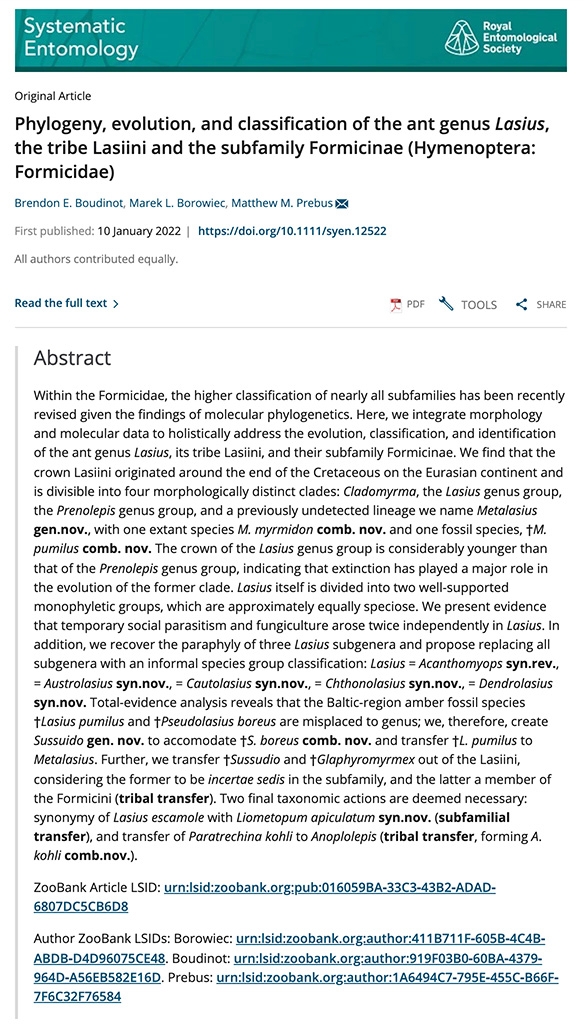
The ant world on Twitter is crawling with congratulatory comments and how "awesome" the work is. Wrote one: "Congratulations! Lasius is a familiar genus in Japan, so I will let the Japanese entomologists know about it."
The story behind the story? It all began in the Ward lab. "The Three Ant Men" are now scattered from Idaho to Arizona to Germany.
- Borowiec, who received his doctorate at UC Davis in 2016, is an assistant professor at the University of Idaho.
- Prebus, who received his doctorate at UC Davis in 2018, is a postdoctoral scholar at Arizona State University.
- Boudinot, who received his doctorate at UC Davis in 2020, is in Jena, Germany on a two-year Alexander von Humboldt Research Fellowship to research evolutionary and comparative anatomy.
"Within the Formicidae, the higher classification of nearly all subfamilies has been recently revised given the findings of molecular phylogenetics," the co-authors wrote in their abstract. "Here, we integrate morphology and molecular data to holistically address the evolution, classification, and identification of the ant genus Lasius, its tribe Lasiini, and their subfamily Formicinae. We find that the crown Lasiini originated around the end of the Cretaceous on the Eurasian continent and is divisible into four morphologically distinct clades: Cladomyrma, the Lasius genus group, the Prenolepis genus group, and a previously undetected lineage we name Metalasius gen.nov., with one extant species M. myrmidon comb. nov. and one fossil species, †M. pumilus comb. nov. " (See more.)
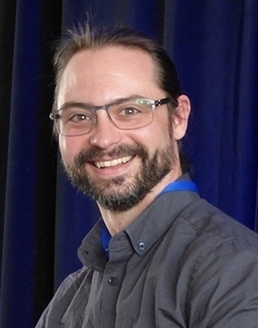
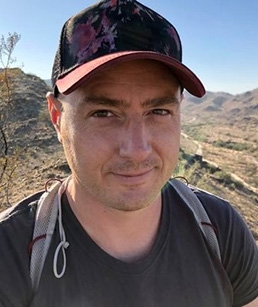
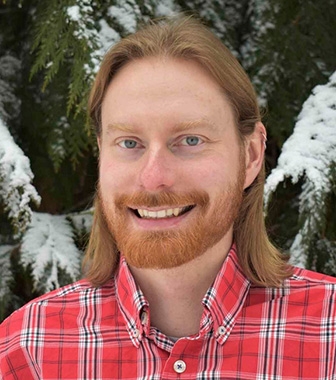
Looking back, Prebus and Borowiec said that they were both interested in Lasius atopus "due to its strange morphology and lack of phylogenetic data despite the amount of attention paid to the genus, and planned a collecting trip to the type locality in Mendocino County in 2013."
The collecting trip to Mendocino proved unsuccessful. "But because of Phil's extensive collections. we knew of a population of a closely related species in Gates Canyon near the city of Vacaville," Prebus said. This time the trio collected specimens from several colonies at Gates Canyon, which is located off Pleasants Valley Road.
"For all of us, this was a collaborative side project, so after the study was presented, submitted, and rejected, it took the back-burner while people finished their dissertations, got jobs, got married, had kids, and so on," Prebus recalled. "Speaking personally, the pandemic put quite a few of my postdoc projects on hold after the Arizona State University campus closed, but the small upside amongst the inundation of downsides was that I was able to focus on getting some long-haul projects into shape for publication, including the Lasius study. This involved a huge amount of reanalysis of data that we had already collected, but thankfully didn't require generating any new data."
"In my opinion, one of the really cool aspects of this study is the method of evaluating the placement of fossil taxa in the phylogeny of the subfamily Formicinae," Prebus shared. "Because DNA data aren't available for fossil taxa, the assignment of fossils to ranks higher than species relies on the interpretation of their morphology, and historically that interpretation has relied heavily on expert opinion--and all of the biases that said experts hold. By collecting morphological data from all extant and fossil taxa in our dataset, we were able to unite the DNA data--from extant taxa--and the morphological data--from extant and fossil species--and formalize fossil placement, and evaluate the uncertainty of those placements, in model-based analyses. I think that this study joins a growing trend in systematics in general, in which we are increasingly moving away from expert opinion toward approaches that are testable and repeatable."
Follow the myrmecologists on Twitter:
- Matthew Prebus at @mmprebus
- B. E. Boudinot at @BoudAnt1
- Marek Borowiec at @mareklborowiec
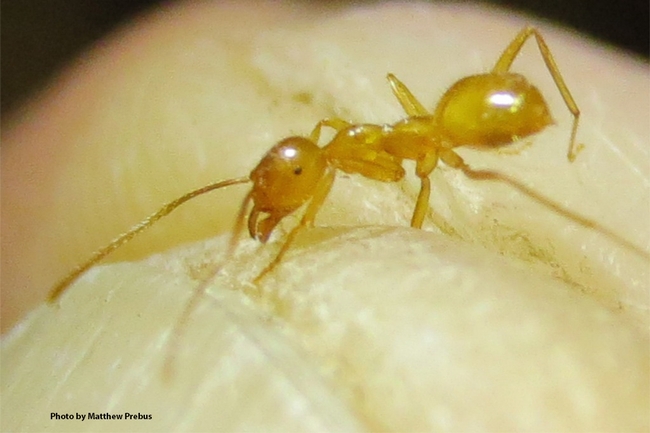
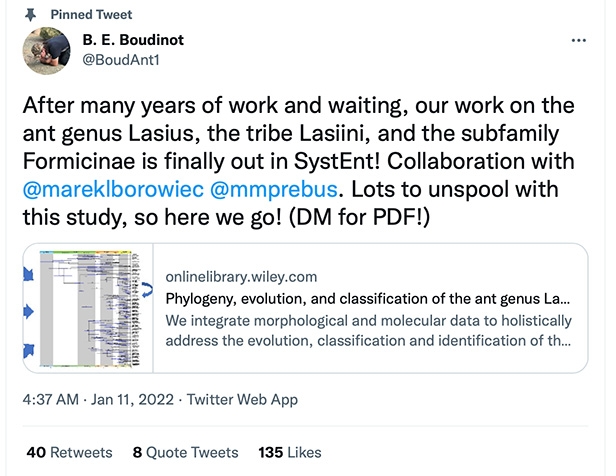
- Author: Kathy Keatley Garvey

- Evolution of floral signals and flower morphology
- Pollinator-drive speciation
- Evolution of floral mimicry
Related Link:
Scholar.google.com
For upcoming seminars, download this PDF
- Author: Kathy Keatley Garvey
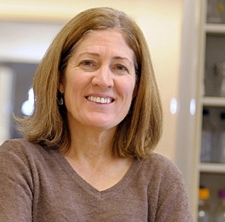
DAVIS--Evolutionary-ecologist Nancy Moran of Yale University will present a "Major issues in Modern Biology" seminar, sponsored by the Storer Endowment in Life Sciences, on Wednesday afternoon, June 5 in the Genome Center Lecture Hall.
Her seminar, titled “Two Sides of Symbiosis in the Ecology and Evolution of Insect Hosts” is at 4:10 and will be followed by a reception in the executive meeting room of the Hyatt Hotel.
Graduate student Leslie Saul-Gershenz of the Neal Williams lab, UC Davis Department of Entomology, will host and introduce her.
Moran’s research involves the evolution of bacterial genomes and of symbiotic associations. She has shown that intimate symbiotic associations date to the origins of major groups of organisms, and she has used genomic and experimental work to show that these associations provide hosts with essential molecules and defenses. She also works on general principles involving the evolution of genomes in bacteria.
“The central role of microbial partners in animal ecology and evolution is more and more evident, but the consequences of associating with beneficial microbes can be mixed,” Moran says in her abstract. “Some of the best examples of how symbiosis affects host evolution and diversification are in insects. Members of this immense, diverse group use a great variety of ecological niches, and encounter many challenges, including nutritional limitations, threats from pathogens and predators, and thermal stress. Bacteria possess genes and pathways that can help insects to overcome these challenges, so it's not surprising that mutualistic associations between insects and bacteria are ubiquitous.
“Symbiont acquisition underlies the success and diversification of some major insect groups. Genomic approaches have elucidated details of these associations in sap-feeding insects such as aphids, revealing mechanisms by which bacterial symbionts assist with host nutrition or with defense against natural enemies. Some insects, such as cicadas and sharpshooters, depend on a small consortium of unrelated bacterial symbionts, and this dependence requires elaborate mechanisms for transferring and packaging the symbionts within the host body.
“But symbiosis has another side, as long-term dependence on symbionts can limit host tolerances, due to degenerative evolution of domesticated symbiotic partners. Obligate symbionts often exhibit signs of genomic degradation and reduction; indeed, the tiniest known bacterial genomes are those of insect symbionts. Insect hosts often are dependent on partners that are increasingly incapable of performing. One evolutionary solution is replacement of ancient symbionts with newly acquired ones, as seen in grain weevils and spittlebugs. Whether symbionts undergo this degenerative evolution depends on whether mechanisms for inter-host transmission impose strict clonality in symbiont populations. “
Moran joined the Yale faculty in 2010 as the William H. Fleming Professor in Ecology and Evolutionary Biology. She obtained her bachelor of arts degree from the University of Texas in 1976 and a Ph.D. in zoology from the University of Michigan in 1982.
From 1986 to 2010, Moran served on the faculty of the University of Arizona, where she was a Regents’ professor. She was awarded a MacArthur Fellowship in 1997, and was elected to membership in the National Academy of Sciences in 2004, the American Academy of Arts and Sciences in 2004, the American Academy of Microbiology in 2004, and the American Association for the Advancement of Science in 2007. In 2010, she was awarded the International Prize for Biology by the Japan Society for the Promotion of Science. She has published more than 190 scientific papers.
The Tracy and Ruth Storer Endowment in the Life Sciences funds the major issues in the Modern Biology Lecture series. This lecture series is designed to bring to Davis eminent biologists whose current work represents the cutting edge of their fields of inquiry. The lectures are open to the entire campus and other interested persons.


